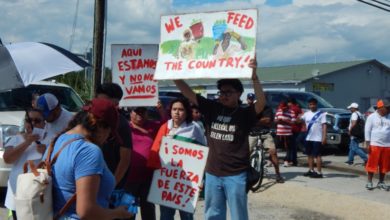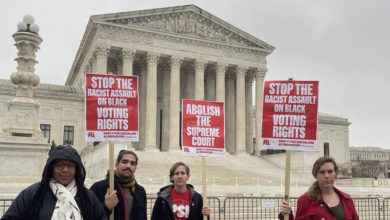On June 25, the Supreme Court struck down three of the four provisions of Arizona’s racist Senate Bill 1070, while upholding the notorious “show me your papers” centerpiece of the law that in practice authorizes racial profiling. This latter provision was upheld unanimously, including by the so-called “liberal” justices Ruth Ginsburg, Stephen Breyer and Sonia Sotomayor.
The defeated provisions included two that created new crimes for working while undocumented and leaving home without carrying immigration papers. They imposed harsh state penalties above and beyond federal law. The third provision allowed police officers to arrest immigrants without a warrant.
The provision of SB 1070 upheld by the Supreme Court requires police to demand immigration papers from anyone they “reasonably suspect” of being undocumented in the course of stopping, detaining or arresting them. While police officers are required to have a reason besides race to initially stop someone, it is known through experience that they invent a thousand petty pretexts to do so.
Democrats enable far-right victory
Despite the fact that the decision preserved this fascistic provision, Democratic Party and liberal organizations were quick to spin the decision as a victory for the Obama administration and the Latino community in general. They left out the fact that Arizona Gov. Jan Brewer and Phoenix Sheriff Joe Arpaio also proclaimed victory.
The Justice Department’s legal challenge to SB 1070, headed by Obama appointee Attorney General Eric Holder, chose not to argue that the bill constituted racial profiling and violated the Equal Protection clause of the U.S. Constitution. Instead, they advanced a relatively apolitical case that SB 1070 was illegal because it “preempted” federal law.
But the Obama administration itself recently ordered states to comply with their draconian Secure Communities program, which requires officers to enter the fingerprints of anyone they arrest into a federal immigration database. The Supreme Court agreed with Arizona’s argument that the “show me your papers” provision was therefore not in conflict with the federal government’s approach towards immigration policy.
The Democratic administration has rapidly escalated the pace of deportations over the last four years. They have mobilized the state apparatus to encourage the targeting of undocumented immigrants and by extension, encouraged racial profiling on the local level. The Democrats’ own policies enabled the far right to win in Arizona, not just poor legal arguments from the Justice Department.
No matter how much the Democrats try to parade their way into winning the Latino vote, their record of targeting, raiding and deporting undocumented immigrants is unmistakable. The general fear and feeling of besiegement in Latino communities has been further punctuated by cases of U.S. citizens being deported because they looked “foreign.”
The explicit targeting of Latino and other immigrant communities is not simply reserved for those without legal status. From the drastic cuts to public schools, to racist stop-and-frisk policies, and the rise of the Latino prisoner population, the trends show that the capitalist state, whether governed by Republicans or Democrats, aims to repress and carefully control poor and working-class Latino communities.
This repression draws on the long history of white supremacy in the United States, a country built on genocide and slavery. It is also a common feature in the treatment of formerly colonized people who migrate to the imperialist centers—for instance, of Koreans in Japan, the Irish and South Asians in England, and Algerians in France.
Imperialism, Latin America and demographic shifts
Why is there wide agreement among both parties of the ruling class to target and persecute Latinos? Do those in power, the vast majority white men, fear the “browning” of the United States?
In May of this year, the Census Bureau reported a milestone in U.S. history. For the first time ever, “minorities” accounted for more than half (50.4 percent) of births, with “Hispanics” the largest group.
More and more, the term the term “Latino” can be used to describe a people whose identity derives from their common position as subjects of colonial and imperialist rule.
With the Monroe Doctrine in 1823, the U.S. ruling classes aimed to keep European colonial competitors permanently out of Latin America. Slaveowners looked to Cuba, Mexico and elsewhere as areas to expand their plantation system based on human bondage, while emerging capitalist elites aimed to secure the region as a vast commercial backyard.
In 1846, the U.S. military invaded Mexico, stealing half its territory. After the territorial conquest over the North American Indigenous people was complete, and the country developed into a full-fledged capitalist-imperialist country, it took the colonies of Puerto Rico, Cuba, the Philippines and Guam from Spain. Using a combination of direct intervention and indirect colonialism, the U.S. ruling class controlled Costa Rica and Panama and propped up “friendly” dictatorships in Guatemala, Honduras, El Salvador, Nicaragua, Brazil, Venezuela, Chile and Haiti.
As such forms of rule became untenable to the image of U.S. “democracy,” and as revolutionary struggles spread throughout the region, the U.S. rulers invented new guises to maintain their “backyard.” The “War on Drugs” became the rationale to intervene in Bolivia and Colombia, while neo-liberal financial policies required the complete integration of the Americas into a world economy dominated by Wall Street.
Each new wave of intervention and set of economic policies produces new rounds of social dislocation, causing spikes in migration from the pillaged country to the pillagers’. These migrations are like fingerprints left behind by the crimes of U.S. imperialism. While the racist right-wing decries the mythical “Brown invasion” of the United States, these demographic trends are the result of the very real invasions in Latin America that have persisted over centuries.
A radical shift in the U.S. working class?
The ruling class of the United States knows this criminal history very well. They fear that the same process of unification and anti-imperialism unfolding in Latin America will manifest within their own borders. They fear the multinational U.S. working class becoming increasingly connected to the struggles of the oppressed nations, and less under the sway of racist and patriotic propaganda.
None of this will develop automatically because of demographic shifts—in fact, it can also create the basis for sharp disunity and a more reactionary politics based on the retention of privileges. But it further lays the material basis for a radical shift within the working class. The anti-racist struggle in the decisive factor.
The massive undocumented workers’ general strike of 2006, the recent bravery of the DREAMers and the groundswell of resistance to SB 1070 show that Latino communities, in unity with all oppressed and exploited sectors of society, are a force capable of bringing about fundamental change.
The more astute members of the ruling class understand this and are hoping to integrate the growing Latino constituencies into the existing political and economic structures with minimal overall disruption. They hope that the growth of a Latino middle class, the sprinkling of Latino faces in the highest levels of society, reinforced by a sharp distinction between “good immigrants” and “bad immigrants,” will prevent the rise of a powerful and politically independent movement that unites workers of all nationalities in common struggle.
The Party for Socialism and Liberation wants to help precisely that type of movement come into existence. Against the Republican and Democratic parties, whose repressive policies and demagogic rhetoric fosters divisions among workers based on race, national background and legal status, we demand full and equal rights for all. No one is illegal! The real criminals are in Washington and on Wall Street!






